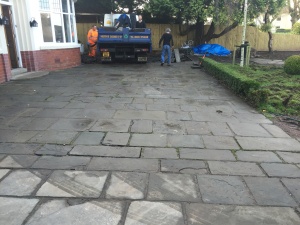The Project: Reclamation of blue Pennant flagstone paving.
 Reclamation Procedure: Merthyr Salvage and Reclamation were responsible for the salvage of multiple paving slabs of the blue Pennant sandstone, which originate from the Neath and Rhondda quarry beds of South Wales. This particular type of stone is over 10,000 years old, and it is ideal for use as paving slabs as it’s known for its durability and high level of frost resistance. It also has a low level of water absorption which means that rain water and frost is held as a thin layer on the surface of the stone, without being held by the stone itself. This means that blue pennant sandstone is non-slippery, and therefore the perfect re-usable material because of its enduring make up.
Reclamation Procedure: Merthyr Salvage and Reclamation were responsible for the salvage of multiple paving slabs of the blue Pennant sandstone, which originate from the Neath and Rhondda quarry beds of South Wales. This particular type of stone is over 10,000 years old, and it is ideal for use as paving slabs as it’s known for its durability and high level of frost resistance. It also has a low level of water absorption which means that rain water and frost is held as a thin layer on the surface of the stone, without being held by the stone itself. This means that blue pennant sandstone is non-slippery, and therefore the perfect re-usable material because of its enduring make up.
Once the team had reclaimed the slabs as whole, intact pieces, they were subsequently sold on to clients to lay as flagstone paving. Despite the cost-effectiveness of using concrete alternatives to flagstones, using reclaimed sandstone, with its healthy re-sale value, is cheaper than buying directly from a quarry supplier. Merthyr Salvage and Reclamation make sure that all reclaimed paving stones are of the best quality, and we are passionate about the character and distinguished appearance that reclaimed stone can add to driveways, paths and pavements. All the materials that we collect are surveyed before we re-sell to our clients to ensure a high standard of quality for your project
Reclamation materials: Materials that were reclaimed on site were as follows:
Blue Pennant sandstone flagstone paving slabs
This item has a high potential for re-sale. This is due to the following factors:
The flagstones were not fractured or flaky
The corners were completely intact
No paint, oil or mortar stains were found on the flagstones
No lanolin was present in the composition of the stone
